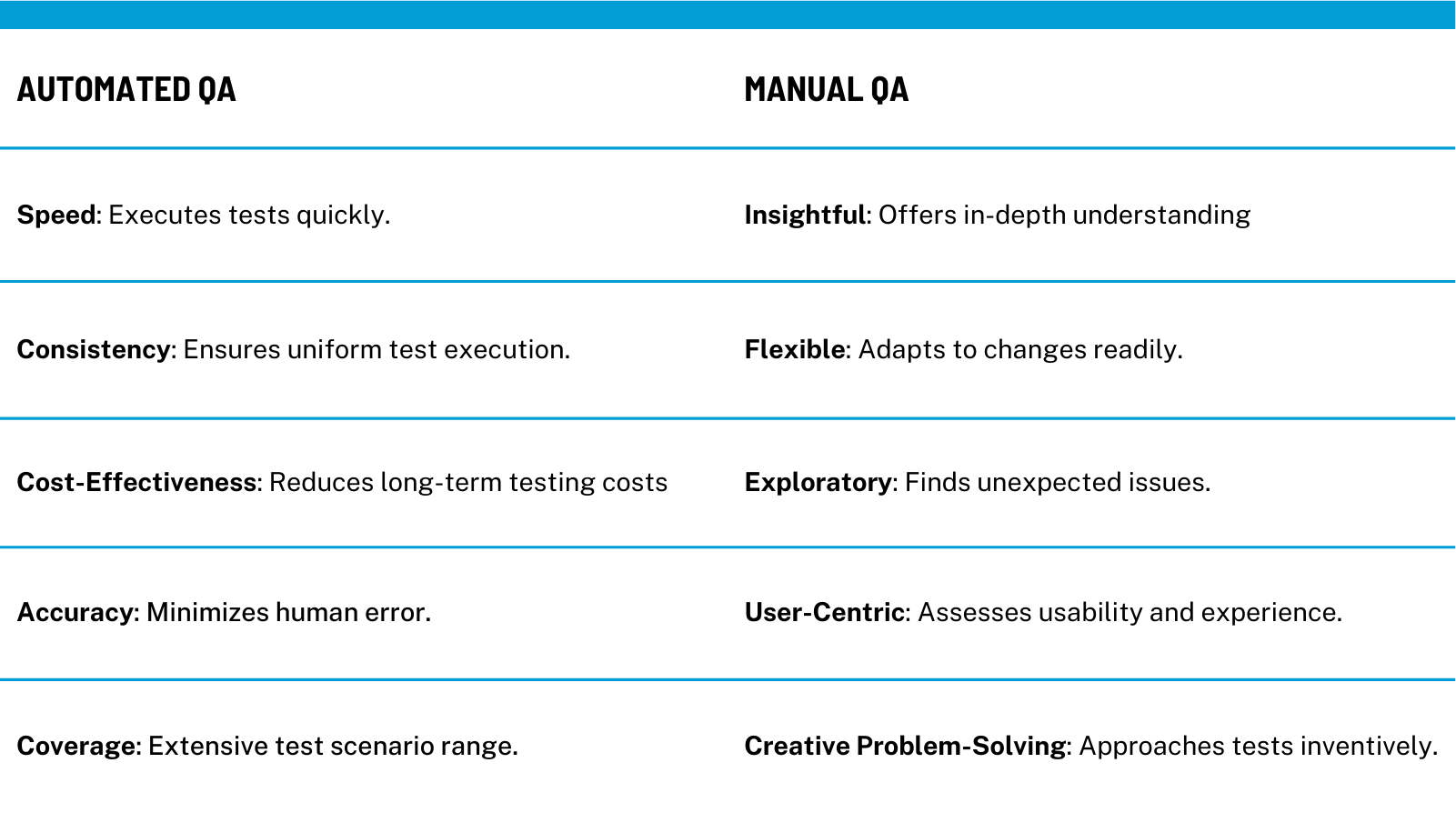Quality assurance (QA) in software development represents a vital intersection of technical accuracy and human acumen. Automated testing tools have revolutionized QA with speed and precision, yet the nuanced judgment and discernment of human experts are essential. This article delves into the symbiotic relationship between automation and human insight in QA processes, underscoring the value of each in the pursuit of software excellence.
The Limitations of Automated Testing
Automated testing is a cornerstone in modern QA methodologies, yet it possesses inherent limitations, especially in tasks demanding complex judgment and understanding of user experiences. These limitations manifest as:
- Challenges in Capturing Subtleties: Automated tools might efficiently execute predefined tests but often lack the ability to perceive subtle user experience issues that a human tester might intuitively notice.
- Difficulty Adapting to Dynamic Testing Scenarios: Automated tests are programmed for specific scenarios, and they might not adapt well to unexpected conditions or complex test cases where human intuition is key.
In recognizing these limitations, it becomes evident that automated testing is not a standalone solution but part of a larger, more comprehensive QA strategy that includes significant human input.
Human Expertise Complementing Automation
The role of human QA professionals transcends supervising automated processes. Their contributions are multifaceted and include:
- Exploratory Testing: Where human creativity and intuition play a pivotal role in uncovering unforeseen bugs and issues.
- Usability Testing: Focusing on the user interface and experience, human testers provide insights into the software’s intuitiveness, a dimension often not fully assessable by automated tests.
- Analyzing and Interpreting Results: Human experts excel in interpreting the outcomes of automated tests, identifying trends, and making strategic recommendations beyond the scope of automation.
In the delicate balance of QA, human insights complement automated processes, leading to a more robust and comprehensive approach. This is particularly crucial in areas like software maintenance, where ongoing evaluation and adaptation are key.

The Balance Between Human Insight and Automation
Achieving the right equilibrium between automated and human elements in QA entails leveraging the strengths of both. Automation enhances efficiency and consistency in routine tasks, while human expertise adds depth and perspective, particularly in:
- Handling Complex Test Scenarios: Addressing complex, unpredictable testing scenarios that require a level of understanding beyond the capability of automated systems.
- Contextual Evaluation and Decision Making: Human insight is invaluable in making contextual evaluations and decisions based on test results, something automation alone cannot achieve.
This harmonious integration ensures a comprehensive QA strategy, culminating in superior software quality.
Evolving Role of QA Professionals
With the proliferation of automation in QA, the role of QA professionals is continually evolving. Today’s QA landscape demands from professionals not only technical skills in automated testing tools but also a suite of soft skills, including:
- Problem-Solving and Critical Thinking: Essential for navigating complex QA challenges and thinking beyond the limitations of automated tests.
- Adaptability and Continuous Learning: Keeping pace with the rapid advancements in QA technologies and methodologies.
This skillset diversification reflects the changing nature of QA roles, emphasizing the importance of human factors in a predominantly automated environment. It also highlights the significance of comprehensive software development metrics in capturing the true quality of software.
Future Trends in QA: Merging Human Expertise with Emerging Technologies
As we look towards the future of quality assurance, it’s clear that the field is poised for transformative changes, driven by advancements in technology and a deepened understanding of the human role in QA. This section explores how emerging technologies are set to enhance the collaboration between human expertise and automated tools, leading to even more effective QA strategies.
Artificial Intelligence and Machine Learning in QA: AI and machine learning are gradually being integrated into QA processes. They offer the potential to automate more complex tasks, such as predictive analysis and adaptive testing strategies, while still relying on human oversight for creative test design and result interpretation.
Augmented and Virtual Reality for Interactive Testing: AR and VR technologies are opening new frontiers in usability testing, allowing human testers to interact with software in more immersive and intuitive ways. This can lead to a deeper understanding of user experiences and more thorough testing of user interfaces.
Advanced Analytics for Deeper Insights: With the integration of advanced analytics into QA processes, human testers will be able to gain more profound and actionable insights from test data. This can lead to more informed decision-making and a more strategic approach to testing.
Enhanced Collaboration Tools: The development of more sophisticated collaboration tools will further facilitate the partnership between human QA teams and automated systems, ensuring seamless communication and more efficient workflows.
Ethical Considerations and Human-Centric Focus: As QA continues to evolve, maintaining a human-centric focus and ethical considerations in software testing will become increasingly important. This includes ensuring that automated testing algorithms are fair, unbiased, and aligned with human values.
Conclusion
The pursuit of excellence in software QA necessitates a blend of automated efficiency and the irreplaceable depth of human expertise. While automated tools offer speed and precision, the nuanced judgment and understanding of human QA professionals are crucial for capturing the full spectrum of software quality.
As the landscape of software development evolves, this synergy between human insights and automated technology remains a key factor in achieving the highest standards of quality.
Contact us to learn more about how we utilize the balanced approach to testing and maintaining a high quality of software solutions that we develop for our clients.